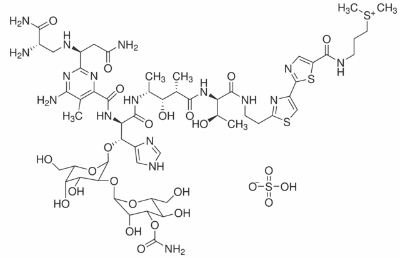
Bleomycin sulfate (Blenoxane) is an anticancer agent for squamous cell carcinomas with IC50 of 4 nM in UT-SCC-19A cells. Bleomycin sulfate inhibits DNA synthesis and causes DNA scissions at specific base sequences. Bleomycin sulfate also inhibits tumor angiogenesis. Bleomycin sulfate causes single and double-strand DNA breaks in tumor cells, which interrupts the cell cycle. Bleomycin is thought to achieve this by chelating metal ions, producing a pseudoenzyme that reacts with oxygen to produce superoxide and hydroxide free radicals that cleave DNA. Bleomycin sulfate-induced telomere instability in mammalian cells persists for several generations after exposure. Moreover, the appearance of telomere fusions in Bleomycin sulfate-exposed cells 10 days after treatment suggests that Bleomycin sulfate can induce delayed telomere instability.

Adv Biol (Weinh). 2023 Feb 12;e2200265.
COVID‐19 Metabolomic‐Guided Amino Acid Therapy Protects from Inflammation and Disease Sequelae
Bleomycin sulfate purchased from AbMole

research square. 2022 July 11.
Neutrophil-driven CD206hiMHCIIlo macrophages are critical for skin fibrosis during systemic sclerosis
Bleomycin sulfate purchased from AbMole

Cell Death Discov. 2022 Nov 26;8(1):466.
Mesenchymal stem cells alleviate systemic sclerosis by inhibiting the recruitment of pathogenic macrophages
Bleomycin sulfate purchased from AbMole
| Cell Experiment | |
|---|---|
| Cell lines | MIA PaCa-2 cell |
| Preparation method | Proliferation assay. The effect of EGCG and BLM on cell proliferation was determined by using TACS 3-(4,5-dimethylthiazol-2-yl)-2,5-diphenyltetrazolium bromide (MTT) cell proliferation assay (Trevigen, Githersburg). The cells (2000 per well) were incubated with EGCG alone, BLM alone or combination of EGCG and BLM, in triplicate in a 96-well plate and then incubated for 2, 4 and 6 days at 37 °C. A MTT solution was added to each well and incubated for 2 h at 37 °C. An extraction buffer (20 % SDS and 50 % dimethylformamide) was added, and the cells were incubated overnight at 37 °C. The absorbance of the cell suspension was measured at 570 nm using a microplate reader (DAS Technologies, Chantilly, VA). This experiment was repeated twice, and the statistical analysis was performed to obtain the final values. |
| Concentrations | 0, 10 and 20 μM |
| Incubation time | 2, 4 and 6 days |
| Animal Experiment | |
|---|---|
| Animal models | |
| Formulation | |
| Dosages | |
| Administration | |
| Molecular Weight | 1512.62 |
| Formula | C55H85N17O25S4 |
| CAS Number | 9041-93-4 |
| Solubility (25°C) | Water ≥ 80 mg/mL |
| Storage |
Powder -20°C 3 years ; 4°C 2 years In solvent -80°C 6 months ; -20°C 1 month |
| Species | Mouse | Rat | Rabbit | Guinea pig | Hamster | Dog |
| Weight (kg) | 0.02 | 0.15 | 1.8 | 0.4 | 0.08 | 10 |
| Body Surface Area (m2) | 0.007 | 0.025 | 0.15 | 0.05 | 0.02 | 0.5 |
| Km factor | 3 | 6 | 12 | 8 | 5 | 20 |
| Animal A (mg/kg) = Animal B (mg/kg) multiplied by | Animal B Km |
| Animal A Km |
For example, to modify the dose of Compound A used for a mouse (20 mg/kg) to a dose based on the BSA for a rat, multiply 20 mg/kg by the Km factor for a mouse and then divide by the Km factor for a rat. This calculation results in a rat equivalent dose for Compound A of 10 mg/kg.
| Related Animal Modeling Products |
|---|
| Astragalus Polysacharin (70%)
Astragalus Polysacharin is a natural product from Astragalus membranaeus, used as adjuvant, attenuates TNF-α-induced insulin resistance by suppressing miR-721 and activating PPAR-γ and PI3K/Akt in 3T3-L1 adipocytes. |
| Myelin Oligodendrocyte Glycoprotein Peptide (35-55), mouse, rat
Myelin Oligodendrocyte Glycoprotein Peptide (35-55), mouse, rat (MOG (35-55)) is a minor component of CNS myelin. |
| PLP (139-151)
PLP (139-151) is amino acid residue 139 to 151 of myelin proteolipid protein (PLP) used to induce experimental autoimmune encephalomyelitis (EAE). |
| G6PI 325-339 (human)
G6PI 325-339 (human) is an efficient inducer of arthritis in B10.Q mice. |
| Heparin sodium salt (MW 15kDa)
Heparin sodium salt (MW 15kDa) is a heparin polymer with a molecular weight of 15kDa.Heparin sodium salt is an anticoagulant that reversibly binds to antithrombin III (ATIII), thereby accelerating the rate of inactivation of Thrombin factor IIa and factor Xa by ATIII. Heparin sodium salt is used for blood collection and plasma preparation in experimental animals and for the construction of parenteral nutrition models in mice. |


Products are for research use only. Not for human use. We do not sell to patients.
© Copyright 2010-2023 AbMole BioScience. All Rights Reserved.
